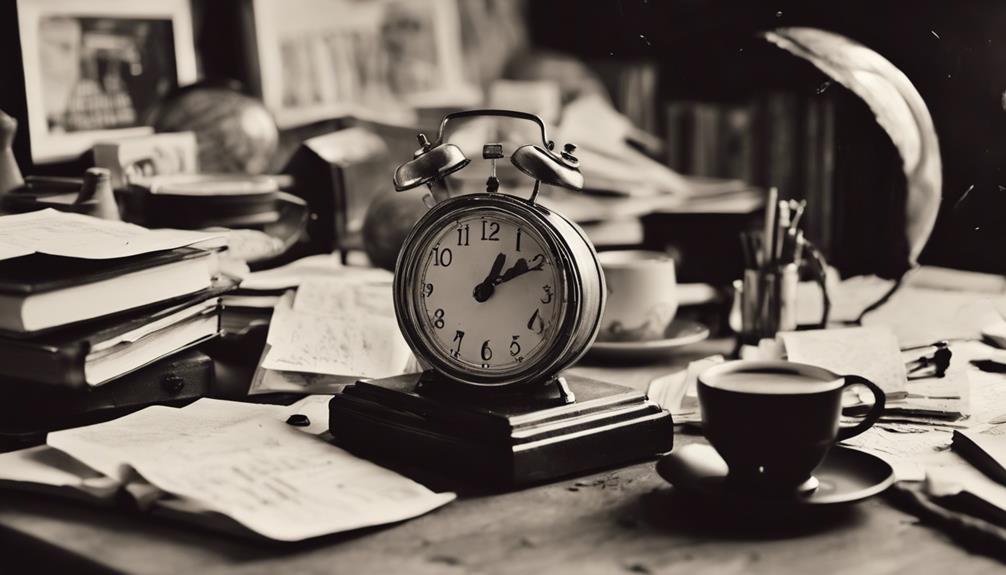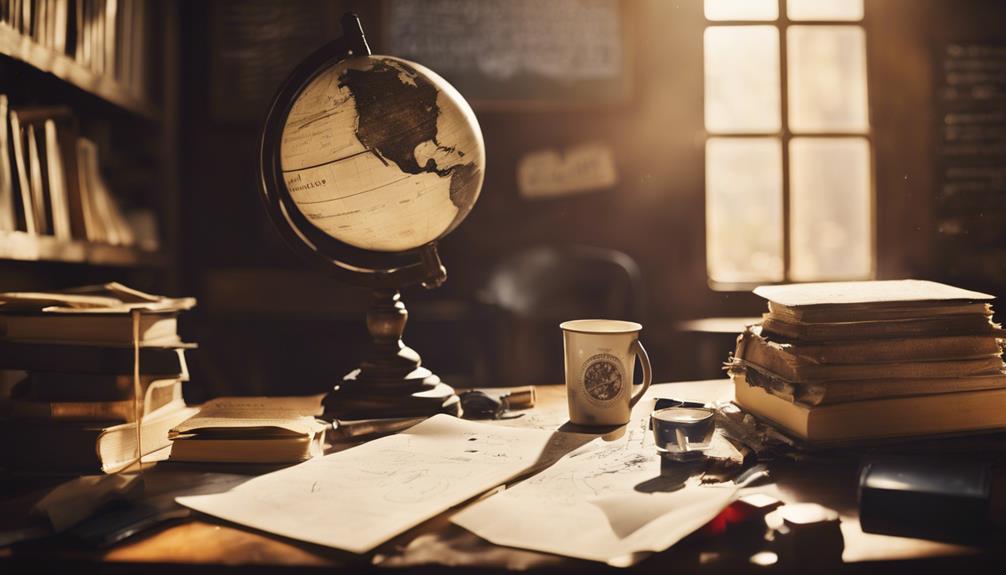Einstein's cluttered desk serves as a symbol of the intricate relationship between creativity and disorder. Research indicates that messy environments can stimulate innovative thinking and encourage unconventional ideas. Similar to other historic figures like Mark Twain and Steve Jobs, Einstein thrived amidst disarray, challenging the belief that organization equals productivity. Cluttered workspaces promote exploration and risk-taking, fostering a unique atmosphere conducive to creativity. This perspective invites a reevaluation of traditional productivity norms, showcasing the benefits of personalized, flexible environments. Understanding these dynamics can greatly influence how one approaches workspace design and creativity. More insights await on this fascinating topic.
Key Takeaways
- Einstein's cluttered desk exemplified his unconventional thinking, reinforcing the idea that creativity can thrive in disorganized environments.
- His workspace, filled with books and papers, stimulated innovative ideas and problem-solving.
- Research indicates that messy environments, like Einstein's, encourage exploration and unconventional approaches to challenges.
- The disarray of his desk reflected a preference for flexibility, allowing for spontaneous thought and creativity.
The Link Between Clutter and Creativity

Research indicates that while clean workspaces promote conventional thinking and decision-making, cluttered environments can considerably enhance creativity and encourage innovative problem-solving.
Studies, particularly by Kathleen Vohs at the University of Minnesota, reveal that messy desks stimulate more creative ideas during brainstorming sessions. Participants working in disorganized spaces tended to favor novel products over traditional options, suggesting that chaos can lead to unconventional thinking.
Conversely, clean environments often encourage conformity and healthier choices, indicating a complex relationship between workspace organization and cognitive processes.
This interplay highlights the potential of clutter to foster risk-taking and exploratory behavior, ultimately contributing to unique and innovative solutions.
Understanding and embracing this dynamic can reshape our approach to enhancing creativity in professional settings.
Iconic Messy Workspaces in History
Throughout history, numerous influential figures have thrived in chaotic environments, exemplifying how messy workspaces can foster creativity and innovation.
Albert Einstein's famously cluttered desk was a representation of his unconventional thinking, housing scattered papers filled with groundbreaking theories.
Similarly, literary giant Mark Twain often worked in disarray, surrounded by books and notes that fueled his imagination.
Steve Jobs embraced a minimalist yet chaotic approach, where ideas flourished amidst disorder.
Mark Zuckerberg's workspace, too, reflected a blend of creativity and chaos, allowing for innovative problem-solving.
These iconic figures demonstrate that messy environments can stimulate unique perspectives, challenging the notion that organization is synonymous with productivity and success.
Their legacies encourage a reevaluation of workspace aesthetics in the pursuit of innovation.
Strategies for Enhancing Creativity

Effective strategies for enhancing creativity often involve tailoring the workspace to align with individual preferences and fostering an environment that encourages exploration and innovation.
To cultivate such an atmosphere, consider implementing the following approaches:
- Create a personalized space that reflects your interests and inspires you, incorporating elements like artwork or plants.
- Encourage non-traditional brainstorming methods, such as mind mapping or sketching, to stimulate free thinking.
- Embrace flexibility in your environment, allowing for occasional messiness that can foster innovative ideas.
Psychological Effects of Workspace Organization

The organization of a workspace markedly influences cognitive processes and creative output, impacting how individuals approach problem-solving and decision-making.
Research indicates that clean environments tend to promote conformity and conventional thinking, while messy settings encourage risk-taking and exploration. This dichotomy illustrates the psychological effects of workspace organization on creativity; clutter may stimulate unconventional ideas and unique solutions, whereas orderliness often leads to traditional responses.
Understanding individual preferences for workspace layout is essential, as it can optimize creative performance.
Additionally, recognizing the psychological implications of a workspace can shift perceptions of productivity, suggesting that a more personalized and potentially chaotic environment might foster innovation and enhance overall cognitive functioning.
Embracing such diversity could benefit various professional settings.
Rethinking Productivity and Innovation

Many organizations are beginning to recognize that traditional notions of productivity may need to be reevaluated in light of the potential benefits associated with creative work environments. Embracing a less conventional approach can foster innovation and inspire new ideas.
Consider the following aspects of creative workspaces:
- Diverse Work Styles: Accommodating various preferences can enhance individual productivity.
- Risk-Taking Opportunities: Messy environments can encourage exploration and unconventional thinking.
- Enhanced Collaboration: Informal settings promote open communication and idea-sharing among team members.
Did Einstein’s Cluttered Desk Influence or Inspire Any Inventions in the 1980s?
Einstein’s cluttered desk may not have directly influenced any inventions that shaped 1980s, but it certainly inspired a new way of thinking. His creative chaos prompted people to embrace unconventional ideas and think outside the box, which ultimately led to groundbreaking innovations in the 1980s.
Conclusion
In the tapestry of innovation, clutter emerges as a vibrant thread, weaving together the chaotic and the creative.
The disarray of Einstein's desk symbolizes a sanctuary for unorthodox thought, where disorder becomes a catalyst for brilliance.
As history's luminaries thrived amidst chaos, the reassessment of workspace organization reveals that true creativity often flourishes in environments that defy conventional norms.
Embracing the unpredictable nature of clutter invites a renaissance of ideas, illuminating pathways to innovation that remain hidden within sterile order.









